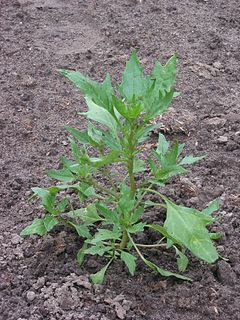
Oxybasis rubra, common names red goosefoot or coastblite goosefoot, is a member of the genus Oxybasis, a segregate of Chenopodium. It is native to North America and Eurasia. It is an annual plant.
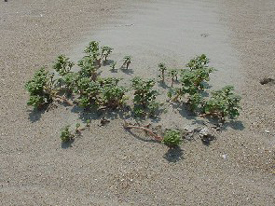
Amaranthus pumilus, the seaside amaranth or seabeach amaranth, is a species of amaranth. This annual plant is now a threatened species, although it was formerly scattered along the eastern coast of the United States, its native range.

Ribes glandulosum, the skunk currant, is a North American species of flowering plant in the currant family. It is widespread in Canada and is also found in parts of the United States.
Puccinellia pumila is a species of grass known by the common names dwarf akaligrass and smooth alkali grass. It is native to North America where it grows along the coastline in the northern latitudes, from Alaska across Arctic northern Canada to Greenland. It occurs on the coast of the Pacific Northwest in the United States and it is known from the Kamchatka Peninsula. The grass is only found on the coast, in wetland habitat, beaches, and areas inundated by the highest tides, in saline sand and mud. This perennial grass grows decumbent or erect to a maximum height near 40 centimeters, often remaining much smaller, especially in harsh habitat. It may root at stem nodes which become buried in wet substrate. The inflorescence is a dense or open array of branches bearing spikelets.

Lythrum alatum, commonly known as winged loosestrife, winged lythrum or angled purple-loosestrife, is a species of flowering plant belonging to the family Lythraceae. It is endemic to wetland areas in central and eastern United States and Ontario.

Rosa nitida, also known as the shining rose due to its glossy leaves, is a perennial species in the plant genus Rosa in the plant family Rosaceae. It is native to northeastern North America, from Connecticut north to Newfoundland and Quebec. It forms a low, suckering, deciduous shrub, growing up to a metre in height, although often less. Its stems are thin and covered in fine bristles. Its pinnate leaves have 7 to 9 shining leaflets which turn bright red, yellow and purple in the fall. Its small pink flowers appear in summer and are subtly but sweetly scented, smelling like Convallaria ("Lily-of-the-Valley"). They are followed by small, round, red hips.

Cirsium horridulum, called bristly thistle, horrid thistle, yellow thistle or bull thistle, is a North American species of plants in the tribe Cardueae within the family Asteraceae. It is an annual or biennial. The species is native to the eastern and southern United States from New England to Florida, Texas, and Oklahoma as well as to Mexico, Belize, Guatemala, Honduras, and the Bahamas.

Solidago latissimifolia, common name Elliott's goldenrod, is North American species of flowering plants in the family Asteraceae. It is native to the Atlantic Coast of the United States and Canada, from Nova Scotia south to Alabama and Florida.

Desmodium sessilifolium, common name sessileleaf ticktrefoil, is a species of plant in the legume family, Fabaceae. It is native to North America.

Botrychium simplex, the little grapefern, is a species of fern in the family Ophioglossaceae that is native to North America and Greenland. It is a perennial.
Linum intercursum, common names sandplain flax and sandplain wild flax, is a perennial plant native to the United States.
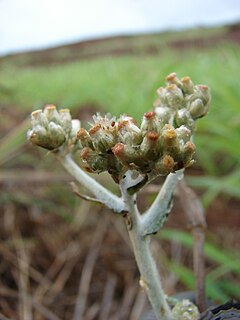
Gamochaeta purpurea, the purple cudweed, purple everlasting, or spoonleaf purple everlasting, is a plant native to North America.
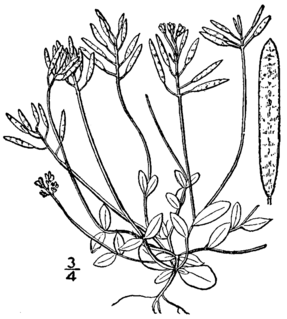
Draba reptans, common names Carolina draba, Carolina whitlow-grass, Creeping whitlow-grass, and Whitlow-grass, is an annual plant in the family Brassicaceae that is native to North America.

Paronychia fastigiata, common names hairy forked chickweed, hairy forked nailwort, and forked chickweed, is an annual plant native to North America.

Carex oligosperma, common name fewseed sedge, few-seeded sedge, and few-fruited sedge, is a perennial plant in the Carex genus. A distinct variety, Carex oligosperma var. oligosperma, exists.

Carex polymorpha common names variable sedge and many forms sedge, is a perennial species of Carex native to North America.
Croton michauxii, commonly known as elliptical rushfoil, and Michaux's croton, is a plant species in the family Euphorbiaceae that is native to the United States. It is an annual plant.
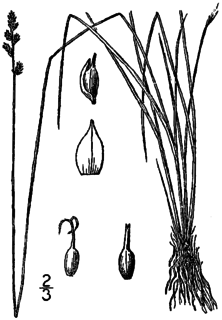
Carex sterilis, common names dioecious sedge, sterile sedge and Atlantic sedge, is a perennial plant native to North America.
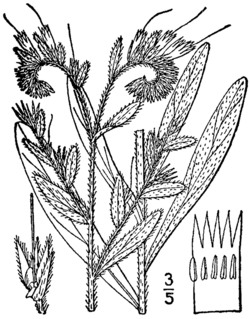
Onosmodium virginianum, common names gravel-weed, wild Job's tears, false gromwell, and Virginia false-gromwell is perennial plant native to the eastern United States.
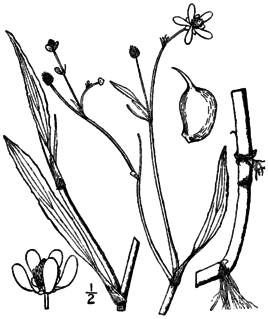
Ranunculus ambigens, common names water-plantain spearwort, water plantain, and spearwort, is a plant found in North America. It is listed as endangered in Connecticut, and New Hampshire, as endangered and extirpated in Maryland, as a special concern in Kentucky, as possibly extirpated in Maine, as threatened in Michigan, and as a special concern in Rhode Island.

















